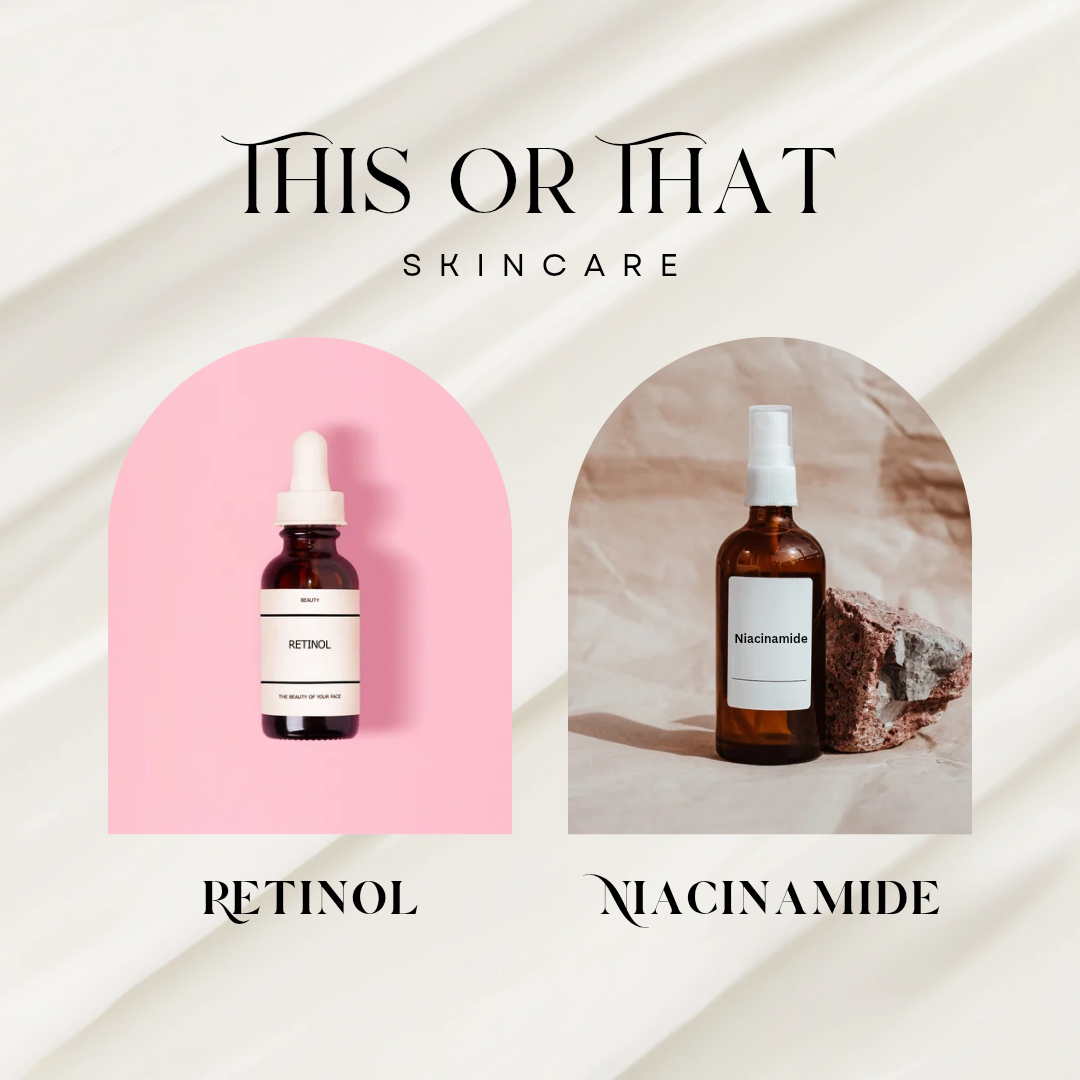The Truth About Niacinamide and Retinol: Do You Need Both?
Skincare can feel like navigating a maze, with endless products promising miraculous results. Two ingredients often steal the spotlight: niacinamide and retinol. Both are celebrated for their ability to transform skin, but do you need both in your routine? In this article, we’ll uncover The Truth About Niacinamide and Retinol: Do You Need Both?, diving into what these ingredients do, how they work together, and whether combining them is worth the hype. With practical tips, expert insights, and science-backed advice, you’ll learn how to use these powerhouses to achieve a radiant complexion. Let’s break it down and find out if your skin needs this dynamic duo.
What is Niacinamide?
To understand The Truth About Niacinamide and Retinol: Do You Need Both?, let’s start with niacinamide. Niacinamide, a form of vitamin B3, is a versatile skincare ingredient known for its multitasking abilities. It’s found in serums, moisturizers, and even cleansers, typically at concentrations of 2–10%. According to the Journal of Clinical and Aesthetic Dermatology, niacinamide offers a range of benefits (Journal of Clinical and Aesthetic Dermatology):
- Brightens Skin: It reduces hyperpigmentation by inhibiting melanin transfer, fading dark spots, and evening skin tone.
- Reduces Redness: Its anti-inflammatory properties soothe irritation, making it ideal for sensitive or acne-prone skin.
- Controls Oil: It regulates sebum production, minimizing shine and clogged pores.
- Fights Aging: Niacinamide enhances collagen production, smoothing fine lines and improving elasticity.
Because it’s gentle and well-tolerated by most skin types, niacinamide is a staple in many routines. However, its benefits depend on consistent use and proper formulation, so look for products with at least 5% niacinamide for noticeable results (Healthline).
What is Retinol?
Next, let’s explore retinol, the other half of The Truth About Niacinamide and Retinol: Do You Need Both?. Retinol, a derivative of vitamin A, is a gold-standard ingredient in anti-aging skincare. It belongs to the retinoid family, which includes over-the-counter retinol and stronger prescription options like tretinoin. Retinol works by accelerating cell turnover, encouraging old skin cells to shed and new ones to form. According to the American Academy of Dermatology (AAD), retinol delivers multiple benefits (AAD):
- Reduces Wrinkles: It stimulates collagen and elastin production, smoothing fine lines and firming skin.
- Fades Dark Spots: By speeding up cell turnover, retinol helps fade hyperpigmentation and age spots.
- Clears Acne: It unclogs pores and prevents breakouts, making it a favorite for acne-prone skin.
- Improves Texture: Retinol refines the skin’s surface, reducing roughness and enlarged pores.
However, retinol can cause irritation, dryness, or peeling, especially for beginners or those with sensitive skin. Starting with a low concentration (0.1–0.3%) and using it 2–3 times a week can minimize side effects (WebMD).
Do Niacinamide and Retinol Work Together?
Now, let’s tackle the core of The Truth About Niacinamide and Retinol: Do You Need Both?: Can these ingredients coexist in your routine? A common myth suggests that niacinamide and retinol cancel each other out, but this is outdated. Early studies hinted that niacinamide might reduce retinol’s efficacy by forming a complex that neutralizes both, but newer research shows they can work harmoniously when formulated or applied correctly (Medical News Today).
Combining niacinamide and retinol can be a game-changer. Niacinamide’s soothing, barrier-strengthening properties counteract retinol’s potential for irritation, making the duo ideal for sensitive skin. Meanwhile, retinol’s exfoliating and collagen-boosting effects complement niacinamide’s brightening and oil-regulating benefits, addressing multiple skin concerns at once. For example, a 2016 study in the Journal of Drugs in Dermatology found that a combination of niacinamide and retinoids improved skin texture and reduced fine lines more effectively than either alone.
However, timing and application matter. Using them together incorrectly can lead to irritation or reduced efficacy. Let’s explore how to combine them for the Ultimate Cuticle Care Routine for Strong, Beautiful Nails.
How to Use Niacinamide and Retinol Together
To maximize the benefits of The Truth About Niacinamide and Retinol: Do You Need Both?, follow these steps to incorporate both into your routine safely:
1. Start with a Clean Slate
Begin with a gentle, pH-balanced cleanser to remove dirt, oil, and makeup. A clean face ensures better absorption of active ingredients. Try Cetaphil’s Gentle Skin Cleanser, which is non-irritating and suitable for all skin types (Cetaphil).
2. Apply Niacinamide First (Morning or Night)
Niacinamide is versatile and can be used morning or night. Apply a niacinamide serum, like The Ordinary’s Niacinamide 10% + Zinc 1%, to damp skin for better absorption (The Ordinary). Use a pea-sized amount and gently pat it into your face. If you’re using it in the morning, follow with a moisturizer and broad-spectrum SPF 30 or higher to protect your skin (Healthline).
3. Use Retinol at Night
Retinol is best applied at night because it’s photosensitive and can break down in sunlight. After cleansing (and applying niacinamide, if using together), wait 10–15 minutes to let your skin dry completely—retinol works best on dry skin. Apply a pea-sized amount of a low-strength retinol, like Paula’s Choice 0.3% Retinol + 2% Bakuchiol, and spread it evenly (Paula’s Choice). Start with 2–3 applications per week, gradually increasing as your skin builds tolerance.
4. Buffer with Moisturizer
To minimize retinol’s drying effects, follow with a rich, hydrating moisturizer containing ceramides or hyaluronic acid. This “sandwich” method—niacinamide, retinol, then moisturizer—reduces irritation while locking in hydration. CeraVe’s PM Facial Moisturizing Lotion, which includes niacinamide and hyaluronic acid, is a great choice (CeraVe).
5. Alternate If Needed
If your skin is sensitive, use niacinamide and retinol on different days or times. For example, apply niacinamide in the morning and retinol at night. This approach still delivers benefits while reducing the risk of irritation.
6. Always Use Sunscreen
Retinol increases sun sensitivity, so daily sunscreen is non-negotiable. Choose a broad-spectrum SPF 30 or higher, like La Roche-Posay’s Anthelios Melt-in Milk Sunscreen, and reapply every two hours if you’re outdoors (La Roche-Posay).
These steps ensure you harness the full potential of The Truth About Niacinamide and Retinol: Do You Need Both? without compromising your skin’s health.
Who Needs Both Ingredients?
So, do you need both niacinamide and retinol? The answer depends on your skin type and goals. Let’s break it down:
- Acne-Prone Skin: Retinol unclogs pores and prevents breakouts, while niacinamide reduces oil and soothes inflammation. Together, they tackle acne and post-acne marks effectively.
- Aging Skin: Retinol’s collagen-boosting and wrinkle-reducing powers pair with niacinamide’s ability to brighten and firm, making them ideal for fine lines and sagging.
- Hyperpigmentation: Both ingredients fade dark spots, with retinol speeding up cell turnover and niacinamide inhibiting melanin production.
- Sensitive Skin: Niacinamide’s calming effects can make retinol more tolerable, but start with low concentrations and alternate use.
- Oily Skin: Niacinamide controls shine, while retinol refines pores, creating a smoother, less oily complexion.
- Dry Skin: Both can work if paired with a hydrating routine, but prioritize moisturizing to counteract retinol’s drying effects.
If you have multiple concerns, like acne and aging or dullness and redness, combining niacinamide and retinol can address them holistically. However, if your skin is very sensitive or you’re only targeting one issue, you might start with one ingredient and add the other later.
Potential Side Effects and How to Manage Them
While niacinamide and retinol are generally safe, they can cause side effects, especially when combined. Here’s how to handle them:
- Retinol Irritation: Redness, peeling, or dryness are common when starting retinol. Use it sparingly (2–3 times a week), apply a moisturizer afterward, and avoid other actives like AHAs or vitamin C on retinol nights (WebMD).
- Niacinamide Sensitivity: Rarely, high concentrations (above 10%) can cause mild stinging or redness. Dilute with a moisturizer or switch to a 5% formula.
- Overloading the Skin: Using too many actives can overwhelm your skin. Introduce niacinamide and retinol gradually, and avoid combining with other potent ingredients like benzoyl peroxide unless advised by a dermatologist.
If irritation persists, consult a dermatologist to adjust your routine or explore alternatives like bakuchiol, a gentler retinol substitute.
Myths About Niacinamide and Retinol
Misconceptions can cloud The Truth About Niacinamide and Retinol: Do You Need Both?. Let’s debunk some myths:
- Myth 1: They cancel each other out. Modern formulations allow them to work together without losing efficacy.
- Myth 2: You can’t use them with vitamin C. While combining retinol and vitamin C can be tricky due to pH differences, using them at different times (vitamin C in the morning, retinol at night) is fine.
- Myth 3: They’re only for aging skin. Both ingredients benefit acne, hyperpigmentation, and texture issues, regardless of age.
Sticking to science-backed advice keeps your routine effective and safe.
Lifestyle Factors to Enhance Results
Skincare ingredients work best when supported by a healthy lifestyle. To amplify The Truth About Niacinamide and Retinol: Do You Need Both?, consider these habits:
- Eat Nutrient-Rich Foods: Vitamins B3 and A, found in foods like eggs, fish, and leafy greens, support the benefits of niacinamide and retinol (Healthline).
- Stay Hydrated: Drink 8–10 glasses of water daily to keep your skin plump and resilient.
- Sleep Well: Aim for 7–9 hours of sleep to allow your skin to repair and regenerate.
- Manage Stress: High cortisol levels can worsen skin issues. Try meditation or yoga to stay balanced (Mayo Clinic).
These habits enhance your skin’s response to niacinamide and retinol, ensuring lasting results.
When to Consult a Dermatologist
If you’re unsure about combining niacinamide and retinol or experience persistent irritation, a dermatologist can help. They can:
- Recommend personalized products or prescription retinoids.
- Address underlying issues like rosacea or eczema that may affect your routine.
- Suggest professional treatments, like chemical peels, to complement your at-home care.
A professional’s guidance ensures The Truth About Niacinamide and Retinol: Do You Need Both? works for your unique skin.
Building a Long-Term Routine
Consistency is key to seeing results. Start with niacinamide daily and retinol a few times a week, gradually increasing as your skin adapts. Monitor your skin’s response and adjust if needed—less is often more with actives. Over time, this duo can transform your complexion, delivering brighter, smoother, and younger-looking skin.
Conclusion
Uncovering The Truth About Niacinamide and Retinol: Do You Need Both? reveals a powerful duo that can elevate your skincare game. Niacinamide’s soothing, brightening benefits pair perfectly with retinol’s anti-aging and acne-fighting powers, making them a versatile combo for most skin types. You can harness their benefits without irritation by using them correctly—starting slow, moisturizing well, and wearing sunscreen. Whether battling acne, wrinkles, or dullness, niacinamide and retinol can help you achieve a radiant, healthy complexion. Start small, stay consistent, and let your skin glow.



